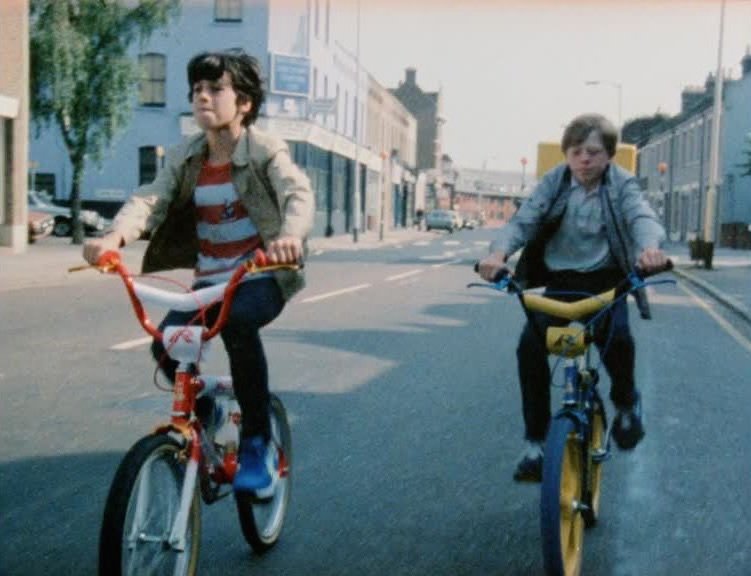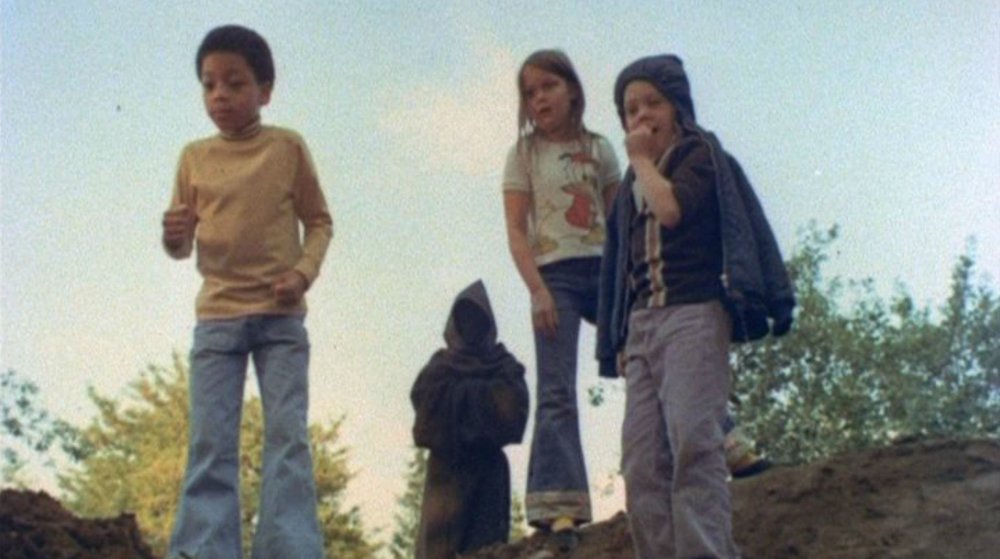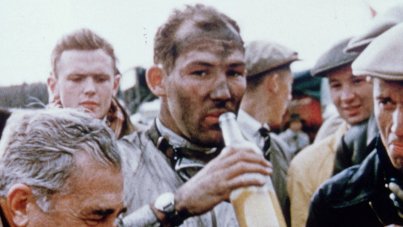
Cyclists Turning Right (1983)
The BFI has released a fascinating new collection of over 100 Public Information Films, available to view free online on BFI Player, drawn from the unique holdings of the BFI National Archive and partner archives across the UK; many are seen here for the first time online alongside acknowledged classics of the genre.
Public Information Films were produced by many different British government departments for over 70 years, mainly through the agency of the Central Office of Information, successor to the wartime Ministry of Information. They have included work by many of the greatest names in British cinema history, including the much-celebrated Richard Massingham, Alberto Cavalcanti, John Grierson, Len Lye and more. But there are many unknown treasures which reveal our recent history in a refreshing and unexpected way. Films which aim to influence the public to cycle carefully, to kill flies, to avoid hazards in the home, to improve typing technique or learn how to talk effectively on the telephone (whether within the civil service or shopping a paramilitary in Troubles-era Northern Ireland), all offer a rare insight into how Britons really lived in the last century.
Robin Baker, Head Curator, BFI National Archive said:
“We are delighted to be making available some of the great Public Information Films from the BFI National Archive on BFI Player. They reveal a fascinating range of insights into attitudes across the 20th century, but also highlight an extraordinary diversity of British filmmaking talent. Many of the films have become iconic. They are often vividly remembered by those who saw them as children and continue to inform ways in which we see the past. The BFI is the guardian of several major government collections including the films of the Central Office of Information and the wartime Ministry of Information which are a unique resource for British social and political history.”
These films were part of a government policy of using films to communicate with a mass audience and represent a real attempt to change behaviours in the interests of public health and safety. During the Second World War they were an essential part of boosting civilian morale and martialling scarce resources, whether they were cabbages, tin cans or bath water; everyone had their part to play in the war effort. In the immediate postwar period, with the nation still reeling from the aftermath of wartime destruction, these films capture the “can do” mood of the period of reconstruction. Social attitudes, culture and heritage are brilliantly conveyed, and often unintentionally revealing of long-forgotten ways of thinking, living and working.

Lonely Water (1973)
Government departments were keen to communicate the implications of new policies such as the introduction of the National Health Service or the need to attract women into the workforce or retain people beyond retirement age. The films were not only widely screened in cinemas but were part of a huge distribution network delivering and screening films in factories, schools, and community halls. Part propaganda, part social engineering, the sometimes patronising tone often gives way to what is brilliantly lyrical filmmaking, evoking British life with an unaccustomed richness prompting nostalgia in contemporary viewers old enough to remember and disbelief from younger viewers.
A flavour of the vanished world captured in these short films is found in some of the titles, How to Use the Telephone (a civil service primer to good communication), Be a Good Cyclist (the rules of the road for health and safety), I Am a Litter Basket (one of a long line of campaigning films trying to educate the public into dealing with litter), Burns and Scalds (sound advice about household dangers, another prolific subject), Mrs T. and Her Cabbage Patch (winning the war with home produced vegetables).
Beyond their ostensible messages, these films all offer insights into changing notions of class, housing, poverty, ingrained social attitudes and public duty. The simple informational style of these films changed to something flashier as the 1960s and 70s demanded stronger messages to stand out against the onslaught of advertising. Television was increasingly the place where most people saw Public Information Films. Some of the best remembered are among the most horrific, as the drive to convince generated some truly nightmarish films highlighting the dangers of electrical substations, train lines, drunk driving, dark ponds or over-friendly strangers. Tufty the Squirrel’s help in educating younger viewers on how to cross the road or Charley Says also aimed at children have achieved cult status among fans of Public Information Films. Just as memorable, the epoch-defining, heavy-hitting public health advertisement the Aids Iceberg is a late example of the genre.
Every generation has its dangers and the Cold War era was particularly alert to the promotion of citizen paranoia. Protect and Survive (1975), an instructive series of animated chapters advising the public on what to do in the event of a nuclear attack, including ‘What to Put in Your Fall-out Room’ and ‘The Importance of Your Radio’, seems unsettlingly naive in its approach, given the scale of the imminent threat. The government eventually realised that the campaign would be ultimately ineffectual in the event of a real attack and it never reached our screens, but the film remains a fascinating record.
12 to try
Typing Technique (1945)
Will plucky Miss Brown sink or swim in the typing pool? The modern word processor has overridden the craft of mechanical typing, with shorthand and carbon copying involving actual carbon largely gone with it. This film uses the dictation of a report on good technique to a hapless typist as a neat, if somewhat patronising, structure. You’d have to be hard-hearted not to sympathise with the delightfully fidgety Miss Brown.
Drink Drive Office Party Cartoon (1964)
The Xmas office party was as boozy in 1964 as any today, but it was another three years before drink drive laws were introduced. This photo montage film was shot in the producers’ offices, and prominently features their head of advertising. More alarming is the final message which, while avoiding the shock tactics of later campaigns, suggests that women are to blame when men drink and drive!
Leading animation company Halas & Batchelor is best known for its feature-length adaptation of George Orwell’s Animal Farm (1955), which used traditional cel animation. The photomontage technique used in this public information ‘filler’ reveals the influence of innovative younger animators such as Bob Godfrey.
Copy Book Please (1949)
Best handwriting, please! An unusually well-spoken postie – in the form of comedian and actor Terry Thomas – instructs the public in the art of addressing an envelope. Short instructional films were a regular feature of the cinema and newsreel theatre programmes during WWII and the post-war period. Like this one, starring the cheeky and charismatic Terry Thomas, they often enlisted the services of the popular radio, theatre and screen performers of the day.
Never Go with Strangers (1971)
Is this the scariest public information film ever? Never Go with Strangers was intended for children aged between seven and 10 and its purpose was ‘to warn them of the dangers of accepting lifts or presents from strangers’. Due to potential distress, government officials instructed that the film only be shown under ‘responsible adult supervision’, thus denying it a TV airing for many years.
But ask any adult who watched the film during the 1970s in their school hall and they will attest to the indelible impression that it made on their young mind. From the opening animation sequences to the unsettling conclusion, the film draws upon the stories of classic children’s fairytales such as Hansel and Gretel and Little Red Riding Hood, to impress upon young innocents that there are wicked people in the world, like the witch and the wolf and the bad uncle, who will use trickery, lures and deception to catch you and hurt you.
With clever but simple techniques such as an off-screen commentator who talks directly to the film’s characters, a looming shadow over a whimpering girl, a pulsating red screen to indicate danger and the morphing of a playground loiterer’s face into a police identikit face of evil, the filmmakers ensure the young audience’s rapt attention.
Peter and the Moon Man (1929)
40 years before Neil Armstrong arrived on the moon, the moon man travelled the other way to learn a lesson in hygiene from little Peter and his mum – at least according to this odd little film from the Health and Cleanliness Council. The film was aimed at working class families, but the Council, tellingly, chose a middle class family in a well-equipped modern house to illustrate its message.
Searching (1974)
The camera’s desperate prowl through a carefully designed wreckage of a set is meticulously planned and expertly executed for maximum impact. Consisting of a mere three tracking shots, joined by barely noticeable dissolves, and occupying a total running time of less than one minute, Searching hits viewers hard where it hurts: their primeval parental fear of their children predeceasing them.
Not for the first time, John Krish turned out a masterful bite-sized slice of ‘public service cinema’ (it is entirely apt to dub Searching ‘cinema’ even though its outlet was TV). It won for the COI a Venice Golden Lion and a Hollywood ‘Spike’ trophy. A generation later, it still hits hard and still hurts.
Pennies (1951)
In this grim film, made by a school headmaster in Burgess Hill, we see pupils, including a boy with his arm in a sling, giving pennies to a teacher. In flashback, we see the boy tinkering with his bicycle’s brakes before he pursues an ice-cream seller. Picking up a friend en route, the two boys collide with a car. We see pennies for ice-cream in the boy’s hand. News from the hospital is not good. Back in the present, we see that the pupils’ pennies are actually for a funerary wreath.
Mr A. C. Barnden, the headmaster of London Road School, Burgess Hill, made several films for the school in the late 1940s and 1950s. He was clearly concerned about the safety of his pupils on the busy roads around Burgess Hill, and, as this film shows, adopted a very direct and shocking way of getting his message across. His other films, intended for use in the classroom, demonstrate a keen interest in capturing aspects of rural life and industry in the locale. Barnden also recorded other school activities such as sports days, school trips and, inevitably, school plays. In 1954 Barnden became headmaster of Oakmeed School and today has a building named after him. London Road School was demolished in May 1989.
Screen Archive South East is a public sector moving image archive serving the South East of England. The archive’s collections of magic lantern slides, films, videos and associated materials capture the many varied aspects of life, work and creativity from the early days of screen history to the present day and serve as a rich and invaluable historical resource.
How to Use the Telephone (1948)
One moment please… Let me put you through to the Kafkaesque world of civil service telephony, an inescapable labyrinth created more by incompetence than malevolence. This clever training film invites the audience to identify good and bad practice themselves, rather than using a didactic voiceover to ram a message home — it even pauses halfway to allow for discussion.
Produced by Richard Massingham’s aptly named Public Relationship Films, the film emphasizes the telephone as a public face — or voice — of the Civil Service. Its effectiveness, particularly in the first half, is thanks to good casting and the performance of the actors. A succession of great expressive faces, including Massingham’s own, are skilfully framed to walk a line between the comedy and frustration of the situations.
Port Health (1967)
Focusing on the Port of London Health Authority’s role regarding London’s sanitation, this film explores life around London’s river, interviewing experts charged with ensuring health standards remain high. This includes such diverse tasks as interviewing immigrants to see if they carry smallpox, examining imported food, inspecting house boats and monitoring the quality of water. We also get to see a captured rat being dissected — “an insurance against plague” — between 12:50 and 13:30, which some viewers may wish to avoid.
Simply Metric (1973)
Oh the joy of 10! Hot on the heels of sterling’s decimalisation in 1971, this short information film from 1973 uses its powers of persuasion– and some help from an animated amoeba – to explain the benefits of metrication to a reluctant British public. Everyday situations – from a couple buying new carpets for their new home to sport and travel – show how easy and unthreateningly familiar metric measures can be.
Despite numerous attempts since the making of this film to persuade the British public to adopt European style weights and measures, full metrication has never been universally achieved. British pubs continue to serve their beer in pints, while petrol is always sold in litres; at the supermarket, milk can be purchased in either imperial or metric measures.
Progressive House (1968)
Welcome to 1968 and the Employment Service Office at Progressive House in Belfast, promising job opportunities across Northern Ireland for gents like those seen in this short promotional film. Progressive House opened on Wellington Place in 1967 and is still home to the Progressive Building Society. This was a ‘filler’ item produced for the Central Office of Information.
Clean Air at Handsworth (1967)
Sheffield signs up for cleaner air in this perky Coal Board promo about Handsworth’s switch-over to smokeless fuel. It’s a delightful window into the swirly-patterned world of ordinary 1960s living-rooms. Twenty-first-century home-owners may also be astounded by the generosity of local government grants.
Though this short film was released in 1973, it’s actually an extract from a longer 1967 production by the National Coal Board Film Unit, advertising the Board’s ‘homewarming’ scheme. The scheme offered no deposit, low interest loans for the purchase of solid fuel appliances which were compatible with ‘homewarm’ — a low cost solid fuel that could be burned ‘smokelessly’.





